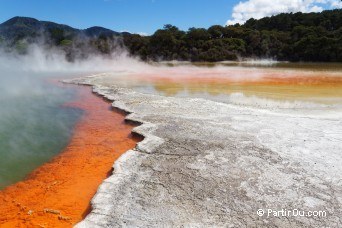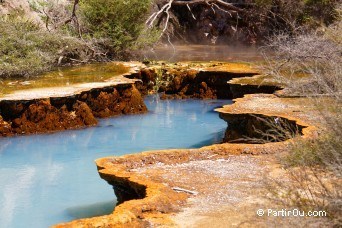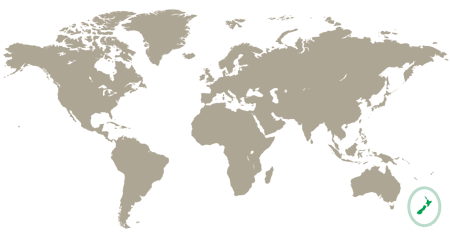
Located in Oceania, one of the seven continents of the Earth, New Zealand is a country of several islands, the two main islands is called "Island of the North" and "South Island". It is on the North Island that was implanted Wellington, the capital.
New Zealand offers visitors a wide range of landscapes and activities: beautiful rugged coastline, beautiful unspoilt forests, volcanic landscapes breathtaking, alpine mountains covered with glaciers, cosmopolitan cities, endemic fauna and flora and even the beaches...
Rotorua is a town located on the North Island; it is located near a lake of the same name: Lake Rotorua. The surrounding area of Rotorua is one of the most visited areas of New Zealand and it is mainly geothermal activity that attracts tourists. Whether observing mud pools, geysers and impressive sulphurous lakes, the area is full of activities related to volcanoes and it is particularly in this region that we become aware of the situation country located between the Australian and pacific tectonic plates. The Pacific plate, which passes under the Australian plate, has a travel speed of about 4 cm per year, which generates this important volcanic activity experienced by New Zealand.
In the "Maori" language, "Rotorua" means "Second Lake"; in the region there is not less than 15 lakes, the largest is Lake Rotorua. The other lakes are Rotoiti, Tarawera, Okataina, Rotomahana, Rewewhakaaitu, Rotoma, Rotoehu, Okareka, Rotokakahi (Green), Tikitapu (Blue), Rotokawau, Ngapouri, Ohakuri, Aitiamuri, Okaro, Ngahewa, Rotokawa etc..
What to do in Rotorua and around?
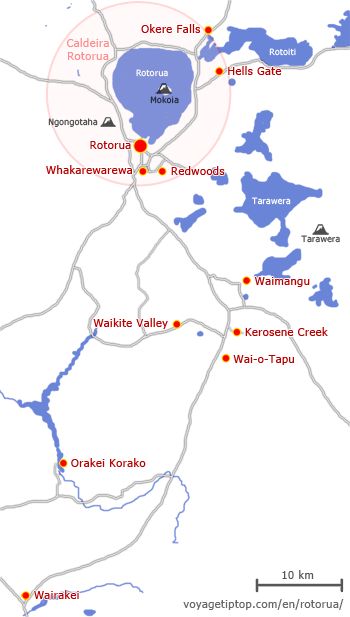
Rotorua activities are numerous and diverse and there is something to do for everyone. Indeed, given to the terrain of the area, lakes, and many natural parks, we can as well go walking on foot or by mountain bike, relax in natural hot springs or in a spa, tease trout in a lake, play golf or be immersed in Maori culture to understand the history of the country... and don't forget all the geothermal activities! Spend a week there is definitely not too much!
Geothermal and volcanic activity
The city of Rotorua is one of the best places in the area to see the power of Mother Nature! Throughout the city we see here and there, fumaroles escaping from the ground between two trees in the middle of a garden or a manhole! The smell of sulfur, which is reminiscent of rotten eggs, is omnipresent in many places. It is true that we are at the heart of a volcano, or rather its caldera, about 22 km (10 miles) wide, which includes Rotorua and its lake. A caldera is a depression, often circular and flat bottom, linked to the collapse of the magma chamber following a volcanic eruption. We are in the heart of Rotorua volcano, although it is not noticeable. Its center is marked by a new volcanic cone, Mokoia Island, in the middle of Lake Rotorua. To understand this region, you must go to the most spectacular places which are mostly paid access. All these natural sites have a Maori legend associated with them.
Are listed below in order of remoteness from the city of Rotorua, interesting geothermal sites (located 80 km (50 miles) from Rotorua):
Kuirau Park
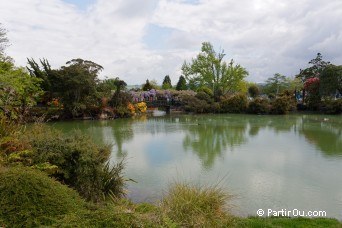
The Kuirau Park (or Kuirau Park) is at the heart of the city of Rotorua. It
is a well landscaped park with trees where one can easily observe geothermal activity

Sulphur Bay
Sulphur Bay is a bay of Lake Rotorua, but it is also a hot spot of the lake. This is also why Rotorua is built in this part of the lake, as the city has always used this natural energy for heating and today to produce electricity. Sulphur Bay is accessible by road and a footpath allows get closer. To get there on foot from the center of Rotorua, just walk 300 meters to the east. The trail starts behind the geothermal power plant or next to the spa center "Polynesian Spa." The trail runs along Sulphur Bay, until Sulphur Point.
Whakarewarewa - The Living Maori Village
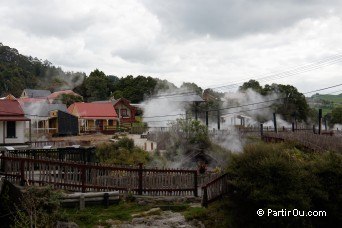
Whakarewarewa is an area of geothermal activity which is north of the city of
Rotorua, between the city and the forest of Whakarewarewa. On part of the
geothermal area is a Maori village (Whakarewarewa - The Living Maori Village) open to visitors (fee; parking lot;

The official website: whakarewarewa.com
Whakarewarewa - Te Puia
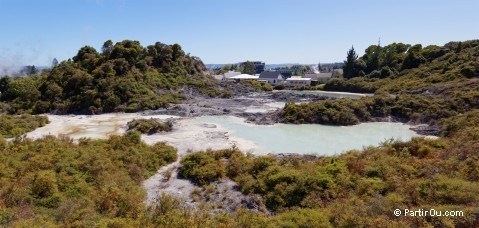
Te Puia is another holding (for tourists) geothermal area Whakarewarewa (parking 1:

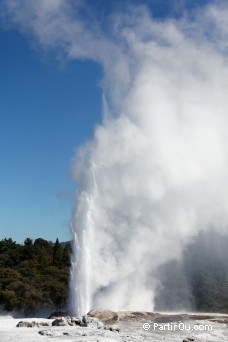
This geothermal activity park is remarkable and is a must! A well marked trail, to go alone or with a guide, lets see closer to 13 geothermal activities in about 1h30 walk. A minibus also runs the main attraction. There are several geysers, but the most famous we note the Pohutu geyser, whose eruption little as 30 meters in height at the rate (on average) an eruption per hour (knowing that it is random and that the geyser may occasionally "spit" several times per hour). The rash can last several tens of minutes. Other geothermal phenomena can be observed in the park such as mud pools.
There is also an observation dome kiwi. The latter being a nocturnal animal,
the dome is plunged into darkness and it is not always easy to locate a kiwi.
There is also a small Maori village reconstituted, called Pikirangi appropriate for children.
The official website: tepuia.com
Tip: you can see free the Pohutu geyser from the path "Pohaturoa track" Redwoods.
Hells Gate
This is a spa center with baths, massages, etc. which also offers a ride in
his big geothermal park. It takes around 1 hour to observe the 22 geothermal
activities including Steaming Cliffs impressive bubbling whose temperature is
122°C (216°F) at the surface or Sulphur Lake, a lake of hot water and mud where it is
allowed to immerse hands! The trail passes through a small lush forest in which
you can discover the Manuka, the Mamaku or Ponga, endemic plants of the country.
At the exit, you are entitled to a course of woodcut. Access to geothermal park
is 25 USD (22 EUR) / adult, it is relatively expensive for what we see (in comparison to
other places in the region). Several options are available when you wish to
enjoy the spa (example price: 63 USD (56 EUR) for the park, the mud bath and sulfur spa; parking:

The official website: hellsgate.co.nz
Waimangu
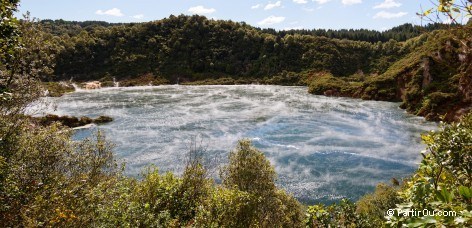
Waimangu (or Waimangu Volcanic Valley) is a beautiful reserve where you can observe the immeasurable force of nature. Here, recent volcanic eruptions took place during the last century (great eruption of Mount Tarawera in 1886). The site is notably composed of a native beautiful forest! A 4 km route (one way; almost constant descent) is proposed to Lake Rotomahana. The tour can be done with a minibus (free), but the hike remain the best way to discover this magnificent site. Moreover, a more difficult variation offers climbing Mt Haszard which has a high elevation and is accessible only by foot. If you do not do this variant, go at least Inferno Crater which is at the beginning of the ascent of Mt Haszard! Our suggested itinerary is to join the Lake Rotomahana possibly via the Mt Haszard walk and then take the mini bus to return, because it rises hard! Of course, the entire site is essential to good weather so the scenery can be appreciated. Among the places not to be missed, there's Cathedral Rocks (Cathedral Rocks) with its steaming rocks, Frying Pan Lake, a lake steaming 55°C (131°F), Inferno Crater (Crater of Hell) for its nice blue water, Birds Nest Terrace and Terrace Wrbrick for their strange formations. From the banks of Lake Rotomahana, you can see Mount Tarawera, an active volcano located on the other side of the lake. A paid option proposes to make a boat trip to observe other volcanic activities around the edges of the lake.
Waimangu site is 23 km (14 miles) far from the city of Rotorua. Given the small size of its car park

The official website: waimangu.co.nz
Kerosene Creek
The free site Kerosene Creek is located 28 km (17 miles) from the city of Rotorua. The
last two kilometers have to go through a track in very bad condition. Once in the parking lot

Wai-O-Tapu
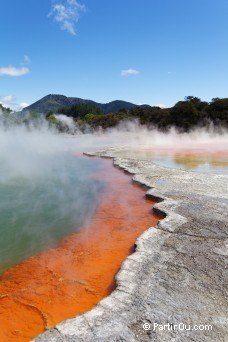
The site Wai-O-Tapu (or Waiotapu Thermal Wonderland) is certainly the
geothermal most visited site in the Rotorua region, according to the size of the
main car park 
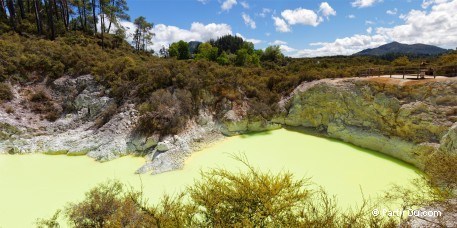
Two other sites has to be seen and are included in the main entrance ticket to Wai-O-Tapu. You can reach them by foot or by car.
Lady Knox Geyser is located 1.2 km from the main site and is visible only in the morning at 10.15, as it is a geyser whose eruption is caused by the lye (a man throw lye in the crater!); the geyser starts to spit water at 20 meters high for several tens of minutes. The site is free to access for the rest of the day.
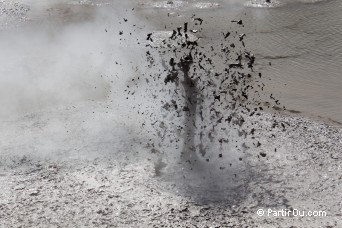
Mud Pool (Mud Pool) is 1.5 km from the main site. This is a pretty impressive mud pond where large bubbles of mud burst on the surface. Unlike other sites Wai-O-Tapu, this place seems to be open access.
The official website: waiotapu.co.nz
Orakei Korako
Orakei Korako (or Orakei Korako Cave and Thermal Park) is a geothermal area
located 70 km (43 miles) from Rotorua. The part that you can visit is located on the shores
of Lake Ohakuri which gives it a special atmosphere. This artificial lake, which
stretches while length of about 10 km (6 milles), only 500 m wide on average. Access to the
spa area of Orakei Korako is from the opposite side (park slot:

The official website: orakeikorako.co.nz
Wairakei
Further south, 75km from Rotorua and only a few kilometers from the large town of Taupo, is the vast area of Wairakei geothermal. Wairakei is first a village, but this geothermal area includes the 4th geothermal power plant the most productive in the world! The area also includes several spas and attractions.
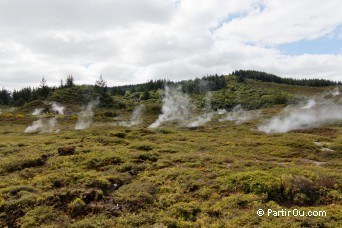
The site Craters of The Moon (or Karapiti Maori) allows to walk an area that
has had several recent volcanic activities; the price is very reasonable (6 USD (5 EUR) / pers.; park slot:

The official website of "Craters of The Moon": cratersofthemoon.co.nz
The "Volcanic Activity Centre" (paid) allows to learn a little more about the
volcanic activity in the region (needs renovation and updating).
Apart from volcanic activity, Wairakei allows the practice of many other
activities thanks to Lake Taupo, rivers, waterfalls, golf course, etc..
Rotorua city
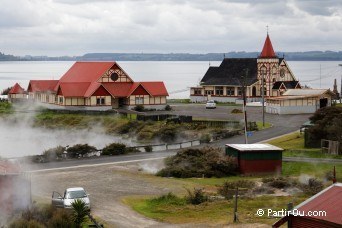
It is pleasant to walk in the city of Rotorua, although the smell of sulfur is often present! Impossible not to notice fumaroles out here and there in some area of the city. Sometimes there is a hole in the garden of a private house... sometimes it's the manholes who smoke!
The area that shows the most this geothermal activity is the Ohinemutu,
located north of the city and near the lake Rotorua

Walking in the Kuirau park is very nice, as well as in the Garden of Government. This includes not only gardens, but also a beautiful building and a museum. A nice path leads along the shores of Lake Rotorua through Sulphur Point and Sulphur Bay.
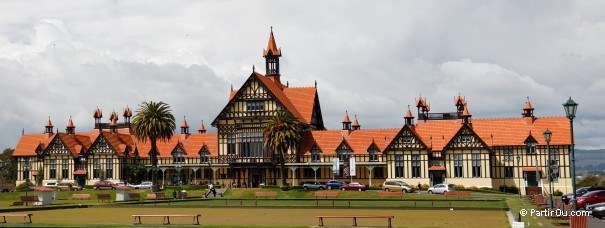
Maori show
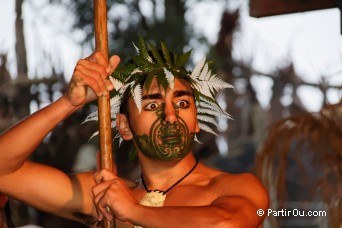
As an integral part of New Zealand culture, Rotorua appears as one of the main living areas of Maori culture. Indeed, nearly 40% of the population of Rotorua is of Maori descent, while it is only 14% over the whole country. The Maori culture is shared with tourists through shows (or dinner shows) offered at an average price of 68 EUR. The meal is normally a traditional Hangi. The show offers visitors demonstrations of old life Maori, as well as traditional dances and fights. See the impressive dance "Haka" generally remains engraved in the memories! Admission tickets are sold either directly on the site or through the Tourist Office (often plus a commission) or via Internet. The hardest part is choosing the right show. Year after year, new centers offer this type of show, each bringing a personal touch. Among the centers / shows offered there are Whakarewarewa - The Living Maori Village, Tamaki Maori Village, Mitai Maori Village and Whakarewarewa - Te Puia.
For some sites, like the "Whakarewarewa - The Living Maori Village", the show is
done during the day, while in the other centers, it takes place in the evening.
Furthermore, "Whakarewarewa - The Living Maori Village" is located in the middle
of the geothermal activities in Rotorua.
"Mitai" is presented in a partially covered room (80 USD (71 EUR) / pers; the show is
well done). Before the show Maori culture is presented and also the preparation
of the Hangi. Then, on a small river in the heart of a beautiful forest, is
sailing a traditional canoe led by Maori (well done). After the show, prepared
meals at "Hangi" can be enjoyed under a heated tent (no charm, simple but good meals).
After the meal, when it is dark night, a stroll is carried out in the forest to observe the glistening glasses (Glowworm).
Therefore, we must bring warm clothes and rain. A flashlight is provided.
Museum
The main museum of the city (near the Garden of the Government) allows a good overview of the history of the locality. There is also an art gallery and temporary exhibitions (visit with or without guide).
Market
A night market is held in the center of town every Thursday from 17h. It is small but ideal for a quick bite of dishes in the world (Thai, French, Italian, Croatian, Japanese, etc.)..
Bath and spa
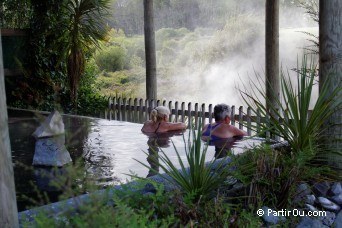
Hydrotherapy (or spa) is widespread in Rotorua and the area is full of spas.
For a moment of intense relaxation do not not hesitate to go to the "Polynesian Spa" www! The thermal water of the "Polynesian Spa" would have therapeutic properties! This center is located on Lake Rotorua at Sulphur Bay and only 300 m from the center of Rotorua. Several packages and prices are available from 11 USD (10 EUR) / adult for the "Family Spa", or 31 USD (30 EUR) / adult for the "Lake Spa". The hottest pool is 42°C (108°F; caution, some pools are not allowed for children).
For a more classical pool, there is the "Aquatic Center", a pool with chlorinated water basins and other thermal water (4 USD (3.50 EUR) / adult).
Some hotels and even some campsites have their own thermal water pool and spa. Private houses also benefit from this inexhaustible source of heat, ecological and free.
You can also go to "Hells Gate" (located 16 km (10 miles) from Rotorua) or to "Waikite Valley Thermal Pools" (35 km from Rotorua). "Waikite Valley Thermal Pools" is a complex amidst geothermal activities which offers several thermal pools whose temperature can reach 39°C (102°F). A short trail, which can be traveled in 10 min, goes near geothermal activities of Waikite Valley. The place has a campsite (14 USD (12 EUR) / pers, access to swimming pools included; www). Much further we can notice the Wairakei area (75 km (47 miles) de Rotorua) with "Wairakei Terraces and Thermal Health Spa" which offers many beautiful thermal pools some of which are arranged in terraces. Just off Wairakei, Taupo town (80 km (50 miles) from Rotorua) also has some thermal baths, the "DeBretts Taupo Hot Springs."
Tourist Office
The city has a great tourist office 
The staff of these "i-site" gives many updated information such as opening hours of a place and rates; it also proposes to make reservations, provides hiking maps, and there is often a free internet WiFi...
Rotorua lake
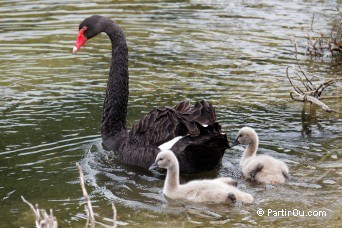
The great lake of Rotorua can be traveled by road; the whole tour is 41 km (25 milles). The lake is the living place of beautiful black swans. At the center of the lake is Mokoia Island which was originally a volcano. From Rotorua, a boat trip can be done on the beautiful "Lakeland Queen", a restored steamer. If you want to admire closer the lake, you can take the small North Road. The hot springs around the lake are numerous.
The Redwoods - Whakarewarewa Forest
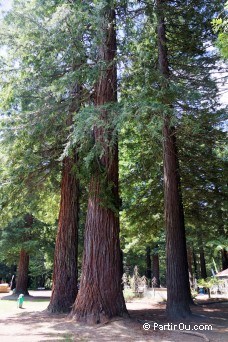
Whakarewarewa Forest is located next to Rotorua. The forest is composed of
hundreds of plant species. 170 species have been introduced in 1901, including
the California redwoods. These redwoods are up to 100 meters high and live for
over 2000 years! By car, simply go to the reception center 
At the reception center, the site is very well explained and many marked trails are available, which vary in length from 30 minutes to 8 hours (2 km to 34 km (21 milles)). All trails are appointed and match a color; Some examples: "Redwood Memorial Grove track" (red, 2 km; 30 min), "Waitawa Walk" (blue, 3.4 km; 1h), "Quarry lookout track" (green, 4.8 km; 1:30) "Pohaturoa track" (yellow, 7.5 km; 2 hours), "Pa Tokorangi track" (purple; 11.5 km; 3:30) and "Whakarewarewa Circuit" (black, 34 km; 8). If you take the trail "Redwood Memorial Grove track", which is only 30 minutes walk, you can observe many redwoods, but also beautiful tree ferns (Mamaku, Ponga, etc.). The forest is just beautiful and you will feel small in the presence of these timber giants! The "Pohaturoa track" trail of 7.5 km has the particularity to be able to observe up to the city of Rotorua, the lake and the Whakarewarewa geothermal site, the Pohutu geyser. On most trails, ATV practice is widely licensed and developed.
The official website: redwoods.co.nz
Other activities
Rotorua and the hole region offer indeed many other activities to tourists or those staying longer. Here are some ideas of complementary activities:
- Rafting and kayaking are proposed by several clubs. Among passable rivers include the Kaituna river that passes by the waterfalls Okere Falls.
- Okere Falls, located 22 km (14 miles) from Rotorua, next to Rotoiti lake. There are several waterfalls easily accessible from the parking lot
located at Troot Pool. There is a long trail of 1.2 km along the Kaituna River through multiple waterfalls. With luck, you will see a raft or kayak down a waterfall. The highest waterfalls is still 26 m! The path joins another parking
. Fishing is permitted from October to late May and most people come for trout.
- "Rainbow Springs" is located just 4.5 km from Rotorua and right next to the place of performance of "Mitai".
This is an animal park and attractions, offering shows with small pets. You can observe lizards, birds (kiwi) and other animal species.
The kiwi is difficult to observe the day because it is a nocturnal animal. However, for a better chance to observe it "awake", the park offers night rides
(
www). Tips: the show "Mitai" offers a combined ticket with a night walk to "Rainbow Springs".
- "Skyline Rotorua" is located right next to "Rainbow Springs". This is a park with many activities such as summer sledging, ziplining, mountain biking, hiking, observing the night sky, etc.. As the site is located on the slopes of Mount (or volcano) Ngongotaha, it has cable cars. It also includes a large restaurant (www).
- "Zorb Rotorua" offers "zorbing" (you can take place in a large inflatable ball and rolling down a slope straight or zigzag).
- "RailCruising" where you can drive cars put on rails (www).
- "Rotorua Canopy Tours": tree climbing (zip lines, walkways, etc.; www)
- "Agrodome": an experience of the farm (sheep shearing, farm animals, etc.; www).
- "Paradise Valley Springs Wildlife Park" is a zoo.
- Horseback riding.
- Do not forget all activities related to the many lakes in the area and in particular the Okareka lake.
- Much further, there is "Kiwi 360", located 50 km (31 miles) north of Rotorua.
"Kiwi360" is at the heart of what is considered the capital of the Kiwi. We
speak here of the fruit, not the animal. The whole area has many farms kiwi.
"Kiwi360" is a public park that reveals the fruit and fruit farm. Be tempted
by the gold kiwi (yellow), a delight! The stores also allow you to discover
many other kiwi-based manufactured products (cosmetics, etc.). (
www)
When to go?
The climate of New Zealand is temperate, with seasons reversed from Europe. The coldest month (austral winter) is July, while January and February are the hottest months. The climate is a bit different on the North Island and the South Island. Rotorua is located on the North Island, the hottest islands. The climate in Rotorua is: in February, he averaged 18°C (64°F); in July, he averaged 8°C (46°F). The summer will be hardly drier than winter. For example, throughout the year, it rains about 2x more than in Paris. Winter is not the best season to travel to Rotorua or, in general, in New Zealand. The summer is better, but the are the long school holidays which begin in mid-December and last about two months. Summer is also the time when there is more "sandflies", a small fly that stings virulently although in Rotorua, its presence is less compared to other regions of New Zealand. Mosquitoes also exist, even with their own variety in Rotorua. If necessary, you have to buy repellents available on site at pharmacies (or supermarket). In conclusion, November, March and April are definitely the best months of the year to travel to Rotorua.
How to get there?
The main means of transportation to reach New Zealand is by air. To get to Rotorua, it is best to choose the city of Auckland or Wellington rigor if there is more availability. From Europe, such a trip is necessarily expensive considering the distance, with an average price of EUR 1,200 round trip, but it is not uncommon to find at least EUR 1,000 or even less EUR 800..
From Auckland, you must drive 220 km (137 miles) to reach Rotorua (distance that can be done by road or by an internal flight). Rotorua has its own airport and flights Auckland - Rotorua are dailies. One can also make a reservation from an european city to Rotorua, the price is sometimes more interesting, instead of performing two independent bookings.
Getting around?
There is no problem to reach other parts of New Zealand by plane or by road
Renting a car is the best way to freely explore this area. Rental prices are quite cheap (less than 23 USD(20 EUR) / day for a small car). Please note that the driving is on the left! The International Driving Licence is required (to be asked in your country).
The van rental or motorhome is widespread in New Zealand. Among the brands that offer the rental of this type of vehicle, there are (in alphabetical order): Alpha Campervans, Apollo, Backpacker Sleeper Vans, Britz, Cheapa, Jucy, Kea, Maui, Mighty, Spaceships, United Campervans, Wendekreisen, Wicked Campers etc.. This solution reconciles the means of travel and accommodation. Campsites are widespread throughout the country. But be careful; the regulation of the wild camping is very strict in New Zealand (see Where you can sleep?).
The bus network is very well developed and organized in New Zealand. It connects all cities, tourist sites, and some beginning or end of hiking trails. The companies are many and you will have no trouble finding locally. Some companies offer "pass" or "Pass" valid for up to 1 year. Thus, with a pass, you can get on and off anywhere and anytime. However, in high season, it is often recommended to reserve a place.
The train exists, but it is not very developed, so movements are restricted.
Where can you sleep?
It will be easy to stay in New Zealand as hotels or motels are numerous. Formula B & B (Bed and Breakfast) is also well developed, as well as affiliated hostels (or not) to the YHA (Youth Hostelling Association; www).
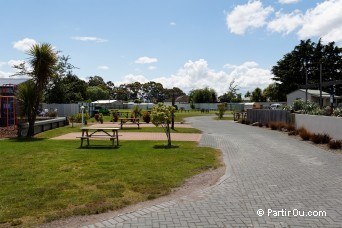
Do not forget campsites, largely developed in New Zealand and often called "holiday park". They can be simple (a field to plant his tent), much more comfortable (with swimming pool, TV room, kitchen fully equipped, etc.) and even propose bungalows or chalets. Among the best campsites, there are those that are part of the group "Top 10". Some campsites offer discounts when a membership card has one (as it's the case for the "Top 10").
Over 200 campsites, usually simple, are administered by the DOC (Department Of Conservation). These have the advantage of being "very cheap" (5 to 11 USD (10 EUR) location) and being often located near beautiful places in nature. Finally, some private land is graciously provided by the owner.
Example of a campsite in Rotorua:
- "Rotorua Top 10" (Superb, very clean, BBQ, full kitchen, TV room,
spa pool 1 + 2 thermal pools (37 and 40 ° C); children's playground; saddly the busy road is nearby;
)
The "wild" camping is widely authorized under 3 conditions:
- there is no prohibition specified;
- whether on land or a public road (not private);
- you are with a certified vehicle "self-contained", in other words, your vehicle has to be autonomous in terms of toilets and has a storage system of wastewater, and this, even if there are toilets nearby; and that, unless otherwise indicated.
To know
Money
The currency of New Zealand is the New Zealand Dollar, abbreviated NZD. On site, there is no problem to change Euros or withdrawal of Dollars with his credit card for ticket banks and retailers are widespread..
Cooking
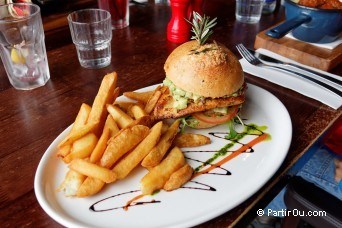
The New Zealand Maori kitchen includes many dishes but also Western dishes sometimes with an English touch. One of typical English dishes is the current Fish'n Chips (or Fish and Chips), a simple dish that is found everywhere, basic fried fish and fries. The most common meat is undoubtedly the sheep, since New Zealand has about 40 million sheep (10x more than people!). The large green mussels, very impressive, are common in some parts of the country.
The Hangi is a traditional Maori method of cooking imported by the descendants came from Polynesia. Cooking food is stewed in a clay oven in the ground that was previously heated over a wood fire. Moreover, it is a cooking excellence in Rotorua, sometimes carried out with the natural heat of the earth (geothermal).
Vegetarian cuisine is fairly common. Do not miss the gold kiwi that we found much better than the traditional green kiwifruit. For the more brave, taste the Vegemite, a spread Australian, salted black, made from fermented yeast (thrills :-))! For fans of sodas, there is the L & P, a soft drink lemon base (Lemon & Paero).
Manuka (cousin of "Tea tree / Melaleuca") is a common plant endemic to New Zealand; it was commonly used in traditional Maori medicine. Try the unique Manuka honey: it has exceptional properties (including antiseptic); the concentration index is indicated by the label "UMF®" (Unique Manuka Factor) or "IAA®" from 0 to 18+ (example UMF®10 +).
Electricity

Voltage is 230 volts, size 2 or 3 flat pins (1 for ground). This format is also used in Australia and several islands of Oceania.
Children
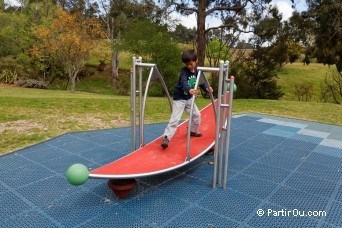
A trip to New Zealand will appeal to a child. The parks of all kinds abound. The playgrounds are amazing, superbly appointed (unheard of elsewhere!). The country's infrastructure will facilitate the trip, even with very small children. Public toilets are many free and generally very clean.
Language
The official language of New Zealand is English, but the Maori is commonly practiced.
Here are some words of the Maori language:
- kia ora: hello
- ka pai: thank you
- haere ra: good bye
- ae: yes
- kaore: no
- marae: meeting place
- manuhiri: guest, visitor
- haka: tribal dance
- roto: lake
- tapu: sacred
- wai: water
- awa: river
- te namu: sandfly
- nui: big
- maunga: mountain
- waka: vehicle
More information...
Discover all our pictures of Rotorua and its surrounding area.
We hope to have given you the wish to explore this beautiful destination!
Emmanuelle and Gilles
